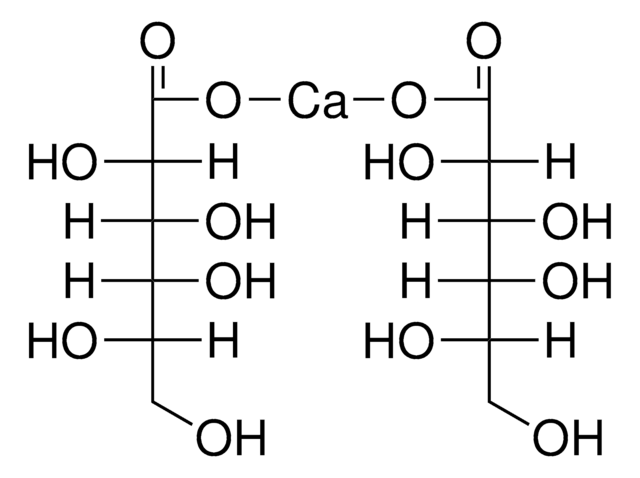91779
3-(3-Hydroxyphenyl)propionic acid
analytical standard
Sinônimo(s):
3-(3-Hydroxyphenyl)propanoic acid, NSC 33135, NSC 39468
Faça loginpara ver os preços organizacionais e de contrato
About This Item
Fórmula empírica (Notação de Hill):
C9H10O3
Número CAS:
Peso molecular:
166.17
Beilstein:
1947445
Número CE:
Número MDL:
Código UNSPSC:
12352200
ID de substância PubChem:
NACRES:
NA.24
Produtos recomendados
grau
analytical standard
Nível de qualidade
Ensaio
≥98.0% (HPLC)
prazo de validade
limited shelf life, expiry date on the label
aplicação(ões)
clinical testing
formato
neat
cadeia de caracteres SMILES
OC(CCC1=CC=CC(O)=C1)=O
InChI
1S/C9H10O3/c10-8-3-1-2-7(6-8)4-5-9(11)12/h1-3,6,10H,4-5H2,(H,11,12)
chave InChI
QVWAEZJXDYOKEH-UHFFFAOYSA-N
Ações bioquímicas/fisiológicas
3-(3-Hydroxyphenyl)propanoic acid is one of the major metabolites of ingested caffeic acid and of the phenolic degradation products of proanthocyanidins (the most abundant polyphenol present in chocolate) by the microflora in the colon. 3-(3-Hydroxyphenyl)propanoic acid is suspected to have antioxidants properties and is actively absorbed by the monocarboxylic acid transporter (MCT) in intestinal Caco-2 cell monolayers.
Código de classe de armazenamento
11 - Combustible Solids
Classe de risco de água (WGK)
WGK 3
Ponto de fulgor (°F)
Not applicable
Ponto de fulgor (°C)
Not applicable
Escolha uma das versões mais recentes:
Já possui este produto?
Encontre a documentação dos produtos que você adquiriu recentemente na biblioteca de documentos.
Os clientes também visualizaram
Letizia Bresciani et al.
Food research international (Ottawa, Ont.), 141, 110137-110137 (2021-03-02)
Cranberries (Vaccinium macrocarpon) represent an important source of anthocyanins, flavan-3-ols and flavonols. This study aimed at investigating in vitro the human microbial metabolism of (poly)phenols, principally flavan-3-ols, of unformulated- and phytosome-formulated cranberry extracts. After powder characterization, a 24-h fermentation with
Eileen Carry et al.
Journal of pharmaceutical and biomedical analysis, 159, 374-383 (2018-07-23)
Grape-derived products contain a wide array of bioactive phenolic compounds which are of significant interest to consumers and researchers for their multiple health benefits. The majority of bioavailable grape polyphenols, including the most abundant flavan-3-ols, i.e. (+)-catechin and (-)-epicatechin, undergo
Jin-Ran Chen et al.
Communications biology, 4(1), 53-53 (2021-01-10)
The G protein-coupled receptor 109 A (GPR109A) is robustly expressed in osteoclastic precursor macrophages. Previous studies suggested that GPR109A mediates effects of diet-derived phenolic acids such as hippuric acid (HA) and 3-(3-hydroxyphenyl) propionic acid (3-3-PPA) on promoting bone formation. However, the
Veronika Pilařová et al.
Talanta, 185, 71-79 (2018-05-16)
Fast, selective, and sensitive ultra-high performance liquid chromatography method with tandem mass spectrometry detection for the determination of quercetin and its metabolites with various physico-chemical properties such as molecular weight, lipophilicity, and acid-base properties has been developed. These compounds included
Johanna Maukonen et al.
Journal of agricultural and food chemistry, 65(18), 3748-3756 (2017-04-27)
Brewer's spent grain (BSG) is the major side-stream from brewing. As BSG is rich in dietary fiber and protein, it could be used in more valuable applications, such as nutritional additives for foods. Our aim was to elucidate whether an
Nossa equipe de cientistas tem experiência em todas as áreas de pesquisa, incluindo Life Sciences, ciência de materiais, síntese química, cromatografia, química analítica e muitas outras.
Entre em contato com a assistência técnica
